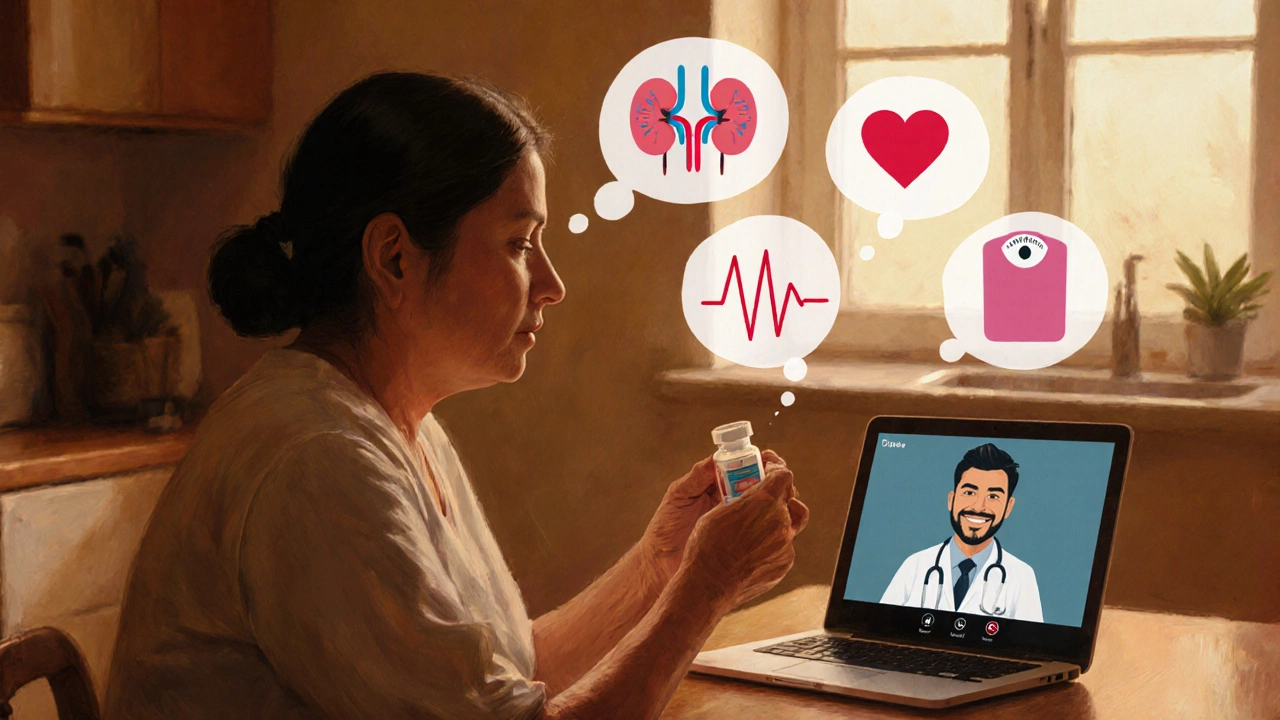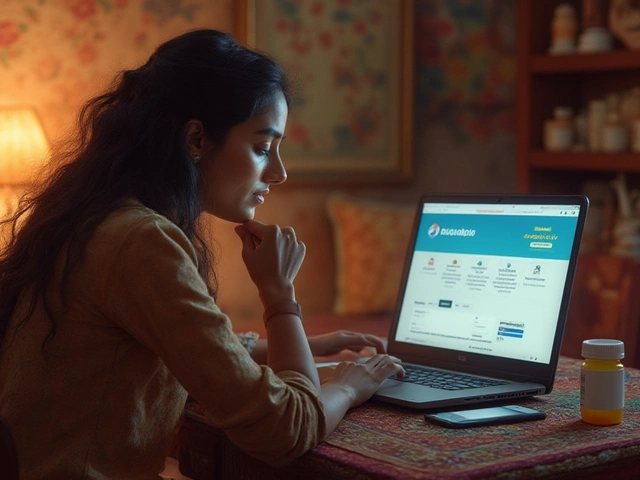Diabetes Medication Safety Calculator
Find the Safest Option for You
Answer a few simple questions about your health to see which diabetes medication class might be safest for you based on hypoglycemia risk, kidney safety, heart impact, and weight effects.
Finding the safest diabetic pill is a top priority for anyone managing type 2 diabetes. Safety isn’t just about avoiding a bad reaction-it’s about choosing a medication that keeps blood sugar steady, protects the heart, kidneys, and weight, and fits your lifestyle.
How Safety Is Measured for Diabetes Pills
Doctors rank a drug’s safety by looking at three core metrics:
- Hypoglycemia risk - how often the drug can cause dangerously low blood sugar.
- Organ impact - especially on kidneys and the cardiovascular system.
- Side‑effect profile - weight gain, GI upset, urinary infections, and long‑term tolerability.
Regulatory agencies like the FDA and EMA require extensive clinical‑trial data for each of these points before a pill hits the market.
Major Classes of Oral Diabetes Medication
While there are dozens of individual drugs, they fall into a handful of well‑defined classes. Below each class is introduced with a brief definition.
Metformin is a biguanide that lowers glucose production in the liver and improves insulin sensitivity. It’s been the first‑line choice for over 60 years and has the longest safety record.
Sulfonylureas are a group of drugs that stimulate the pancreas to release more insulin. Common agents include glimepiride and gliclazide.
SGLT2 inhibitors work by blocking glucose reabsorption in the kidneys, causing excess sugar to be expelled in urine. Examples are empagliflozin and dapagliflozin.
DPP‑4 inhibitors increase levels of incretin hormones, which help the body release insulin only when blood sugar is high. Sitagliptin and linagliptin belong to this class.
GLP‑1 receptor agonists mimic the incretin hormone GLP‑1, boosting insulin secretion, slowing gastric emptying, and often promoting weight loss. Although most are injectable, oral semaglutide entered the market in 2023.
Safety Profile Comparison
| Drug Class | Hypoglycemia Risk | Renal Safety | Cardiovascular Impact | Weight Effect |
|---|---|---|---|---|
| Metformin | Very Low | Generally safe; caution if eGFR <30 mL/min | Neutral to modest benefit (reduced CV events in UKPDS) | Neutral or slight loss |
| Sulfonylureas | Medium‑High (especially with long‑acting agents) | Safe unless severe renal impairment | Neutral; some data suggest increased CV risk with older agents | Neutral or mild gain |
| SGLT2 inhibitors | Very Low | Requires eGFR ≥45 mL/min for initiation; can cause dehydration | Significant CV and renal benefit (e.g., EMPA‑REG OUTCOME) | Modest loss |
| DPP‑4 inhibitors | Low | Safe down to eGFR 30 mL/min (dose‑adjusted) | Neutral; no major CV outcome benefit | Neutral |
| GLP‑1 receptor agonists (oral) | Low | Generally safe; monitor for pancreatitis | Positive CV outcomes (e.g., REWIND trial) | Weight loss (2‑4 kg avg) |
From the table it’s clear that **Metformin** and **SGLT2 inhibitors** sit at the top of the safety ladder, while older sulfonylureas carry a higher hypoglycemia risk.
Choosing the Safest Pill for Your Situation
Safety isn’t one‑size‑fits‑all. Your personal health profile decides which pill is truly the safest.
- Kidney function - If eGFR is below 45, Metformin dose must be reduced or stopped, and SGLT2 inhibitors may be off‑label.
- Heart health - Patients with established ASCVD benefit most from SGLT2 inhibitors or GLP‑1 agonists.
- Risk of low blood sugar - Those who have had hypoglycemia episodes should avoid sulfonylureas.
- Weight concerns - If weight loss is a goal, consider SGLT2 inhibitors or oral GLP‑1 agents.
- Cost and access - Generic Metformin remains the cheapest and widely available option.
Talk to your endocrinologist about your eGFR, blood pressure, and lifestyle. A shared decision‑making approach ensures the pill you pick aligns with both safety data and personal preference.
Common Misconceptions About Diabetes Pill Safety
Myth 1: All pills are equally safe if the doctor prescribes them. In reality, each class carries unique risk profiles. Even a well‑meaning prescription can be unsafe if you have hidden kidney disease.
Myth 2: Natural or herbal supplements are automatically safer. Some herbs (e.g., bitter melon) can cause severe hypoglycemia, especially when combined with prescription drugs.
Myth 3: Side‑effects mean the drug is unsafe. Mild GI upset with Metformin often resolves with a slow titration schedule; it doesn’t outweigh the cardiovascular benefit.

Quick Checklist for Picking the Safest Pill
- Confirm kidney function (eGFR) - Metformin safe if eGFR ≥30, SGLT2 safe if ≥45.
- Assess heart disease risk - prioritize SGLT2 or GLP‑1 agents for ASCVD.
- Review history of low blood sugar - avoid sulfonylureas if you’ve experienced episodes.
- Consider weight goals - choose agents that promote loss or are weight neutral.
- Check insurance coverage - generic Metformin is cheapest; newer agents may need prior authorization.
Following this list can help you land on the medication that offers the best balance of glucose control and safety.
Frequently Asked Questions
Is Metformin the safest option for everyone?
Metformin has the lowest hypoglycemia risk and a strong cardiovascular record, but it’s not ideal for people with severe kidney disease (eGFR <30 mL/min) or chronic intestinal disorders.
Can SGLT2 inhibitors cause infections?
Yes, they increase urinary tract and genital yeast infections because they push sugar into the urine. Staying hydrated and good hygiene reduce the risk.
Do sulfonylureas still have a role?
They’re inexpensive and effective for people who can tolerate the hypoglycemia risk, especially in low‑resource settings. Newer agents are preferred when safety is the priority.
What about weight gain with diabetes pills?
Most agents are weight neutral, but sulfonylureas and thiazolidinediones can cause modest weight gain. SGLT2 inhibitors and GLP‑1 agonists often lead to loss.
Are oral GLP‑1 drugs as safe as injectables?
Oral semaglutide shows a safety profile comparable to the injectable version, with the same low hypoglycemia risk and cardiovascular benefit. GI side‑effects may be slightly higher during initiation.
Remember, the “safest” pill is the one that matches your health numbers, lifestyle, and budget. Keep monitoring labs regularly, stay in touch with your healthcare team, and adjust therapy as your condition evolves.






